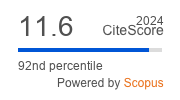SMART FOOT MONITORING: A CUTTING-EDGE SOLUTION FOR EARLY DETECTION OF DIABETIC COMPLICATIONS USING CNN MODEL
DOI:
https://doi.org/10.29284/ijasis.10.1.2024.45-55Keywords:
Convolutional neural networks, raspberry pi, internet of things, diabetic patients, heel pressure.Abstract
The proposed system for early detection of diabetic complications incorporates advanced technology into conventional algorithms, employing intelligent sensors that communicate to a Raspberry Pi with the Internet of Things infrastructure. It significantly improves the therapy that is provided to diabetic patients. The processing of real-time data, which may include heel pressure, temperatures, and habits of motion, is carried out using a Convolutional Neural Network (CNN) model. The CNN can differentiate between healthy foot health and the early indicators of chronic problems, which enables distant surveillance and prompt treatments to reduce the risk of the consequences of diabetes. A cloud-based infrastructure provides physicians with quick notifications, whereas a user-friendly experience allows individuals to take control of their health. The implementation of this innovative solution represents a big step forward in the treatment of diabetic foot conditions. It offers a proactive approach to ensuring the health and well-being of patients and improving systemic administration. The effortless adoption of the system into everyday life highlights its potential to transform diabetic treatment practices. This makes it possible to ensure a comprehensive, successful technique for minimizing foot issues in those who have diabetics.
References
P. M. Kumar, S. Lokesh, R. Varatharajan, G. C. Babu and P. Parthasarathy, “Cloud and IoT based disease prediction and diagnosis system for healthcare using Fuzzy neural classifier,” Future Generation Computer Systems, vol. 86, 2018, pp. 527-534.
F. Abdali-Mohammadi, M.N. Meqdad and S. Kadry, “Development of an IoT-based and cloud-based disease prediction and diagnosis system for healthcare using machine learning algorithms,” IAES International Journal of Artificial Intelligence, vol. 9, no. 4, 2020, pp. 766-771.
N. R. Sivakumar and F. K. D. Karim, “An IoT based big data framework using equidistant heuristic and duplex deep neural network for diabetic disease prediction,” Journal of Ambient Intelligence and Humanized Computing, 2021, pp. 1-11.
A. Naseem, R. Habib, T. Naz, M. Atif, M. Arif and S. Allaoua Chelloug, “Novel Internet of Things based approach toward diabetes prediction using deep learning models,” Frontiers in Public Health, vol. 10, 2022, pp. 1-11.
I. Raeesi Vanani and M. Amirhosseini, “IoT-based diseases prediction and diagnosis system for healthcare,” in the Internet of Things for Healthcare Technologies, 2021, pp. 21-48.
A. Hebbale, G. H. R. Vinay, B. V. Krishna and J. Shah, “IoT and machine learning based self care system for diabetes monitoring and prediction,” in 2nd Global Conference for Advancement in Technology, 2021, pp. 1-7.
S. Padhy, S. Dash, S. Routray, S. Ahmad, J. Nazeer and A. Alam, “IoT-based hybrid ensemble machine learning model for efficient diabetes mellitus prediction,” Computational Intelligence and Neuroscience, vol. 2022, 2022, pp. 1-12.
M. Bhatia, S. Kaur, S. K. Sood and V. Behal, “Internet of things-inspired healthcare system for urine-based diabetes prediction,” Artificial Intelligence in Medicine, vol. 107, 2020, pp. 1-16.
N. Verma, S. Singh and D. Prasad, “Machine learning and IoT‐based model for patient monitoring and early prediction of diabetes,” Concurrency and Computation: Practice and Experience, vol. 34, no. 24, 2022, pp. 1-17.
P. Kaur, N. Sharma, A. Singh and B. Gill, “CI-DPF: A cloud IoT based framework for diabetes prediction,” in IEEE 9th Annual Information Technology, Electronics and Mobile Communication Conference, 2018, pp. 654-660.
R. Ani, S. Krishna, N. Anju, M. S. Aslam and O. S. Deepa, “IoT based patient monitoring and diagnostic prediction tool using ensemble classifier,” in International Conference on Advances in Computing, Communications and Informatics, 2017, pp. 1588-1593.
S. S. Sarmah, “An efficient IoT-based patient monitoring and heart disease prediction system using deep learning modified neural network,” IEEE Access, vol. 8, 2020, pp. 135784-135797.
A. R. Nasser, A. M. Hasan, A. J. Humaidi, A. Alkhayyat, L. Alzubaidi, M. A. Fadhel, J. Santamaría and Y. Duan “IoT and cloud computing in health-care: A new wearable device and cloud-based deep learning algorithm for monitoring of diabetes,” Electronics, vol. 10, no. 21, 2021, pp. 1-12.
R. Krishnamoorthi, S. Joshi, H. Z. Almarzouki, P. K. Shukla, A. Rizwan, C. Kalpana and B. Tiwari, “A novel diabetes healthcare disease prediction framework using machine learning techniques,” Journal of Healthcare Engineering, vol. 2022, 2022, pp. 1-15.
N. L. Fitriyani, M. Syafrudin, G. Alfian, and J. Rhee, “Development of disease prediction model based on ensemble learning approach for diabetes and hypertension,” IEEE Access, vol. 7, 2019, pp. 144777-144789.
Downloads
Published
Issue
Section
License
Copyright (c) 2024 S. Murugan, N. Mohankumar

This work is licensed under a Creative Commons Attribution 4.0 International License.
This work is licensed under a Creative Commons Attribution 4.0 International License, which permits unrestricted use, distribution, and reproduction in any medium, provided the original work is properly cited.











